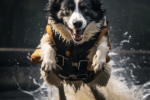Unleashing Canine Intelligence: Brain Training for Dogs

Canine Intelligence Brain Training: Dogs are known for their loyalty and companionship, but have you ever wondered just how intelligent they can be? Canine intelligence is a fascinating topic that explores the mental capabilities of our beloved four-legged friends. From problem-solving to learning and memory, dogs possess a range of cognitive abilities that vary from breed to breed.
In this article, we will delve into the world of canine intelligence, exploring different types of intelligence, testing methods, and the benefits of brain training. You will discover how to engage your dog’s cognitive abilities, strengthen your bond, and unlock their hidden potential.
Intelligence in dogs can be categorized into three main groups. Instinct intelligence is derived from their breed and includes tasks such as guarding, herding, or retrieving. Adaptive intelligence involves problem-solving and learning from experience, and working & obedience intelligence refers to a dog’s ability to learn and follow instructions from humans.
You might like dog IQ tests. Towel, hidden reward, cup, problem-solving, and beyond the barrier tests assess memory and problem-solving. While these tests may not show your dog’s intellect, they reflect cognitive abilities. Brain training improves dog mental health. Dog brain training improves behavior, minds, and friendships. Playing puzzles, obedience, nose work, agility, and clicker training keep dogs smart. Brain training requires consistency, positive reinforcement, increasing challenges, and customisation. Every dog is different, so recognizing their needs and abilities is crucial. Brain training boosts your dog’s intelligence, friendliness, and behavior. Dog IQ tests are fun but lack problem-solving and memory. Every dog has different intelligences and strengths, so understanding this is vital. Rewarding dog brain training. It helps thinking, family peace, and memory. Ready to learn your dog’s IQ?
Understanding the Different Types of Canine Intelligence
Canine intelligence can be categorized into three distinct groups, each representing different aspects of a dog’s mental abilities. These categories include instinct intelligence, adaptive intelligence, and working & obedience intelligence.
Instinct intelligence is derived from a dog’s breed and encompasses tasks that come naturally to them. For example, herding breeds have a strong instinct to gather and control livestock, while guarding breeds are naturally protective. Retrievers excel in retrieving objects, showcasing their instinctual abilities.
Adaptive intelligence focuses on problem-solving and a dog’s ability to learn from experience. It involves tasks that require cognitive thinking, such as finding hidden treats or solving puzzles. Dogs with high adaptive intelligence show resourcefulness and can quickly adapt to new situations.
Working & obedience intelligence refers to a dog’s capacity to learn and follow instructions from humans. This type of intelligence is commonly seen in service dogs, guide dogs, and working breeds trained for specific tasks. They excel in obedience training, responding to commands, and performing complex tasks.
Understanding these different types of canine intelligence can help dog owners identify and appreciate their dog’s unique mental capabilities. By recognizing their strengths, owners can tailor training activities and engage their dogs in ways that stimulate their specific intelligence, creating a fulfilling and enriching experience for both the owner and the dog.
Testing Your Dog’s Intelligence
Curious to know just how smart your furry friend is? There are a variety of tests you can try to gauge your dog’s intelligence. These tests assess different problem-solving and memory skills, giving you insights into your dog’s cognitive abilities. Let’s explore some of the popular tests:
The Towel Test
In this test, place a towel over your dog’s head, covering their eyes. Observe how long it takes for them to free themselves from the towel. Dogs that quickly shake off the towel show good problem-solving skills and spatial awareness.
The Hidden Treat Test
Hide a treat under a cup or in a box and watch how your dog finds it. This test measures their ability to remember the location of hidden objects and their problem-solving skills in retrieving the treat.
The Which Cup Test
In this test, place a treat under one of three cups and shuffle them around. See if your dog can identify the correct cup containing the treat. This test assesses their ability to follow visual cues and make accurate decisions.
The Problem-Solving Test
Present your dog with a puzzle toy that requires them to manipulate parts or solve a series of steps to reach a hidden treat. Observe how they approach the puzzle and how long it takes them to solve it. This test measures their problem-solving abilities and perseverance.
The Beyond the Barrier Test
Set up a barrier, such as a baby gate, and place a treat just out of reach on the other side. Observe how your dog tries to get to the treat. Dogs that display creative problem-solving skills, such as using their paw or nose to push the treat closer, demonstrate higher intelligence.
| Test | Skills Assessed |
|---|---|
| Towel Test | Spatial awareness, problem-solving |
| Hidden Treat Test | Memory, problem-solving |
| Which Cup Test | Visual cues, decision-making |
| Problem-Solving Test | Problem-solving, perseverance |
| Beyond the Barrier Test | Creative problem-solving |
While these tests can provide valuable insights into your dog’s intelligence, it’s important to remember that they primarily focus on problem-solving and memory skills. Each dog is unique, and intelligence comes in different forms, so it’s essential to appreciate your dog’s individual strengths and abilities.
The Benefits of Brain Training for Dogs
Engaging in brain training with your dog offers a multitude of benefits, benefiting both their mental and physical well-being. By providing them with mental stimulation, brain training exercises help keep their minds sharp and active, preventing boredom and potential behavior problems.
One of the significant advantages of brain training is the improvement in a dog’s behavior. By challenging their cognitive abilities, dogs become more focused and attentive, reducing destructive behaviors and increasing their overall obedience. This not only creates a more harmonious home environment but also strengthens the bond between the owner and the dog.
“Brain training exercises help dogs to develop problem-solving skills, boost their confidence, and enhance their mental and physical health.”
Another key benefit is the positive impact on a dog’s mental and physical health. Engaging in brain training exercises helps dogs utilize their natural instincts and abilities, keeping them mentally stimulated and preventing cognitive decline. Additionally, regular mental exercise can also have a positive effect on a dog’s physical health, as it often involves physical activities like puzzle toys or agility training.
Techniques for Engaging Canine Intelligence
There are various techniques that can be employed to engage a dog’s cognitive abilities. Puzzle toys are a popular choice as they require dogs to solve a task or find hidden treats, stimulating their problem-solving skills. Obedience training allows dogs to learn and follow instructions, challenging their adaptive intelligence. Nose work activities tap into their instinct intelligence by using their sense of smell to locate specific scents. Agility training provides a mental and physical workout, requiring dogs to navigate obstacle courses and follow commands. Lastly, clicker training utilizes positive reinforcement, helping dogs associate specific behaviors with rewards and improving their learning and memory capabilities.
With consistent training, positive reinforcement, and a personalized approach, brain training can unlock a dog’s hidden potential and help them reach new levels of intelligence and behavior. Every dog progresses at their own pace, so patience and understanding are essential throughout the process. By embarking on this journey together, you can create a lifetime of cherished memories and a closer bond with your furry companion.
| Benefits of Brain Training for Dogs | Description |
|---|---|
| Mental Stimulation | Engaging in brain training exercises keeps a dog’s mind sharp and active, preventing boredom and behavior problems. |
| Improved Behavior | Challenging a dog’s cognitive abilities through brain training enhances their focus, obedience, and overall behavior. |
| Strengthened Bonds | Brain training creates a deeper bond between the owner and the dog, fostering a harmonious home environment. |
| Mental and Physical Health | Regular mental exercise through brain training improves a dog’s mental and physical well-being, preventing cognitive decline and providing physical activity. |
| Increased Confidence | Brain training exercises help dogs develop problem-solving skills, enhancing their confidence and self-assurance. |
Techniques for Engaging Canine Intelligence
There are various techniques and activities that can enhance your dog’s cognitive abilities and engage their intelligence. By providing mental stimulation and challenging their problem-solving skills, you can help unleash their true potential. Here are some effective methods to engage your dog’s intelligence:
- Puzzle toys: These interactive toys require your dog to figure out how to access a hidden treat or solve a problem. They promote problem-solving skills and keep your dog mentally engaged.
- Obedience training: Teaching your dog basic commands and tricks not only strengthens the bond between you and your furry friend but also stimulates their mind. It challenges them to learn and follow instructions, improving their cognitive abilities.
- Nose work: Dogs have an incredible sense of smell, and engaging them in scent-based activities can be both mentally stimulating and rewarding. Introduce them to scent detection games and let them use their nose to find hidden treats or objects.
- Agility training: This physically demanding activity also requires mental focus and problem-solving skills. By navigating through obstacle courses, your dog will improve their cognitive abilities as they learn to overcome challenges and follow your commands.
- Clicker training: Clicker training is a positive reinforcement technique that involves associating the sound of a clicker with a reward. By breaking down complex tasks into smaller, manageable steps, you can engage your dog’s intelligence and teach them new behaviors.
Engaging Your Dog’s Intelligence
Remember, consistency is key when engaging your dog’s intelligence. Regular practice and positive reinforcement will help them grasp new concepts and improve their problem-solving abilities. Adjust the difficulty level gradually to ensure your dog is challenged but not overwhelmed. Every dog is unique, so tailor the training approach to their individual needs and strengths.
By incorporating these techniques into your dog’s routine, you can provide them with the mental stimulation they need to thrive. Engaging their intelligence not only keeps them entertained but also strengthens the bond between you and your furry companion. So, why not start exploring these techniques today and unlock your dog’s hidden potential!
| Technique | Description |
|---|---|
| Puzzle toys | Interactive toys that require problem-solving skills to access hidden treats or solve a puzzle. |
| Obedience training | Teaching your dog basic commands and tricks to stimulate their mind and improve cognitive abilities. |
| Nose work | Scent-based activities that engage your dog’s sense of smell and promote mental stimulation. |
| Agility training | Physically demanding activities that challenge your dog’s problem-solving skills and obedience. |
| Clicker training | A positive reinforcement technique using a clicker to associate behaviors with rewards and engage your dog’s intelligence. |
Keys to Successful Brain Training
Unlocking your dog’s intelligence through brain training requires certain key elements to ensure success. Consistency is crucial in establishing a routine and maintaining regular training sessions. By consistently engaging your dog’s cognitive abilities, you create a structured environment that promotes learning and growth.
Positive reinforcement is another essential component of successful brain training. Rewarding your dog for desired behaviors encourages them to repeat those actions, reinforcing their understanding of the task at hand. It’s important to use rewards that are meaningful to your dog, whether it’s verbal praise, treats, or playtime.
Implementing incremental challenges is necessary to keep your dog engaged and prevent boredom. Gradually increase the difficulty of tasks as your dog becomes more proficient, encouraging them to continue learning and problem-solving. This approach helps to build their confidence and allows them to reach their full potential.
A personalized approach to brain training is vital because every dog is unique. Understand your dog’s individual strengths, preferences, and limitations, and tailor your training methods accordingly. By adapting the training approach to suit your dog’s needs, you create an environment that maximizes their learning potential and ensures a positive training experience.
| Keys to Successful Brain Training | Description |
|---|---|
| Consistency | Establish a regular training routine |
| Positive Reinforcement | Reward desired behaviors to promote learning |
| Incremental Challenges | Gradually increase the difficulty of tasks |
| Personalized Approach | Adapt the training to suit your dog’s individual needs |
By incorporating these key elements into your dog’s brain training regimen, you can unlock their hidden potential and foster a deeper connection with them. Remember to be patient and celebrate their progress along the way. With consistency, positive reinforcement, incremental challenges, and a personalized approach, you can help your dog reach new heights of intelligence and create a fulfilling and enriching bond.
Progress and Rewards in Brain Training
Witnessing your dog’s intelligence and behavior grow through successful brain training is an incredibly gratifying experience. As you engage your furry friend in various cognitive tasks and challenges, you’ll start to notice noticeable progress in their problem-solving abilities, memory skills, and overall intelligence.
When you introduce puzzle toys or set up problem-solving tests, you’ll observe how your dog becomes more adept at finding solutions and accomplishing tasks. It’s truly amazing to witness their determination and focus as they work through each challenge. These small victories not only demonstrate their growing intelligence but also build their confidence and self-esteem.
The positive changes in behavior are also remarkable. Regular brain training sessions help dogs channel their energy and mental stimulation in a productive way, reducing destructive behaviors such as excessive barking, digging, or chewing. The mental exercise provided by brain training keeps them engaged and content, resulting in a calmer and more well-behaved companion.
Furthermore, the bond between you and your dog deepens through the process of brain training. As you spend quality time together working on puzzles, training exercises, or engaging in other cognitive activities, you’ll establish a stronger connection based on trust and communication. This shared experience strengthens your relationship and creates a sense of mutual understanding and companionship.
| Rewards of Successful Brain Training | Benefits |
|---|---|
| Increased Intelligence | Improvement in problem-solving and learning abilities |
| Positive Behavior | Reduction in destructive behavior, increased focus and relaxation |
| Bond Strengthening | Enhancement of the owner-dog relationship, improved communication |
| Improved Quality of Life | Greater mental and physical stimulation, overall well-being |
Limitations of Dog IQ Tests
Although canine IQ tests can reveal problem-solving and memory skills, they are not reliable intelligence tests. These tests focus on specific cognitive talents and may not fully assess a dog’s intelligence.
Dog IQ tests focus on problem-solving, which is a drawback. These tests generally require canines to find hidden rewards, overcome barriers, or solve riddles. These tasks can show a dog’s critical thinking and problem-solving skills, but they may not show social or emotional intelligence.
Another drawback is that dog IQ testing focus on memory. They test a dog’s memory for knowledge or tasks. Though crucial, memory is only one part of intellect. Traditional IQ tests may not accurately assess dogs’ abilities to learn new commands or adapt to new conditions.
Table: Dog IQ Test Limitations
| Limitation | Description |
|---|---|
| Focus on problem-solving | Tests mostly evaluate a dog’s problem-solving skills, overlooking other forms of intelligence. |
| Emphasis on memory | Tests often measure a dog’s memory capabilities, neglecting other cognitive abilities. |
| Limited assessment scope | Tests may not capture the full range of a dog’s intellectual capacities, such as social or emotional intelligence. |
Despite these drawbacks, canine IQ testing can be entertaining and challenging for dogs. They can help owners engage their pets in mentally engaging activities by indicating a dog’s problem-solving and memory skills. However, canine intelligence is diverse and can emerge in many ways, so it’s important to consider a dog’s individual skills and abilities when assessing their intelligence.
The Unique Intelligence of Every Dog
Just like humans, dogs possess different forms of intelligence, and each has its own unique set of strengths. Understanding and appreciating these individual capabilities can deepen our bond with our furry companions and enhance our approach to training and enrichment activities.
Intelligence in dogs is not limited to problem-solving skills or obedience training. It extends to various other aspects, such as social intelligence, emotional awareness, and sensory perception. Some dogs excel at reading human emotions, while others have an exceptional sense of smell or hearing.
To better understand and utilize a dog’s unique intelligence, it’s essential to observe and identify their strengths. For example, a Border Collie’s instinct intelligence may shine in herding tasks, while a Labrador Retriever’s adaptive intelligence may make them quick learners in various activities.
Exploring Canine Intelligence
| Types of Intelligence | Examples of Unique Strengths |
|---|---|
| Instinct Intelligence | Breed-specific tasks like guarding, herding, retrieving |
| Adaptive Intelligence | Problem-solving and learning from experience |
| Working & Obedience Intelligence | Ability to learn and follow instructions from humans |
By recognizing and appreciating the unique intelligence of our dogs, we can tailor their training, activities, and overall care to suit their individual needs. This personalized approach not only maximizes their potential but also strengthens the bond between human and canine.
So, the next time you interact with your four-legged friend, take a moment to consider their particular strengths and abilities. Embrace their individuality and nurture their intelligence in a way that brings out the best in them. Together, you can navigate the world, explore new challenges, and create lifelong memories of mutual growth and companionship.

Conclusion
Brain training your dog can strengthen your bond and improve your life. Dog intelligence is divided into instinct, adaptation, and working & obedience. Breed-specific instincts include protecting and retrieving. Working and obedience intelligence is a dog’s ability to understand and follow human commands, while adaptive intelligence is problem-solving and experience-based.
A dog’s intellect can be tested using the towel test, concealed treat test, which cup test, problem-solving test, and beyond the barrier test. These tests can examine problem-solving and memory skills, but they don’t necessarily measure intellect.
Dog brain training improves behavior, bonding, mental and physical health, and confidence. Puzzle toys, obedience training, nose work, agility training, and clicker training can stimulate a dog’s brain and influence its behavior. Brain training requires consistency, positive reinforcement, progressive difficulties, and personalization. Each dog learns at their own rate, so patience is essential. Watching a dog’s intelligence and conduct improve is enjoyable and strengthens the owner-dog link, improving quality of life.
Despite their limitations, canine IQ tests are fun and can indicate a dog’s problem-solving and memory ability. Individual dogs have different intelligences and capabilities. Finally, brain training your dog can improve communication and comprehension. It stimulates your dog’s mind, produces harmony at home, and generates memories. Start unlocking your dog’s intelligence and see the amazing changes.
FAQ
Q: What are the different types of canine intelligence?
A: Canine intelligence can be categorized into instinct intelligence, adaptive intelligence, and working & obedience intelligence.
Q: How can I test my dog’s intelligence?
A: There are several tests you can try, including the towel test, hidden treat test, which cup test, problem-solving test, and beyond the barrier test.
Q: What are the benefits of brain training for dogs?
A: Brain training provides mental stimulation, improves behavior, strengthens bonds, enhances mental and physical health, and increases confidence.
Q: What techniques can I use to engage my dog’s intelligence?
A: You can use puzzle toys, obedience training, nose work, agility training, and clicker training to engage your dog’s cognitive abilities.
Q: What is the key to successful brain training?
A: Consistency, positive reinforcement, incremental challenges, and a personalized approach are essential for successful brain training.
Q: What rewards can I expect to see in my dog’s progress?
A: Brain training can lead to improvements in intelligence, behavior, the bond between you and your dog, and overall quality of life.
Q: Are dog IQ tests accurate indicators of overall intelligence?
A: Dog IQ tests primarily focus on problem-solving and memory skills and may not be accurate indicators of overall intelligence.
Q: Do all dogs have the same type of intelligence?
A: No, intelligence comes in different forms, and every dog has its own unique strengths and abilities.






